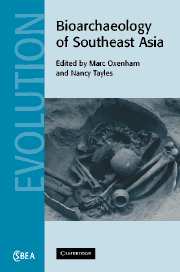Book contents
- Frontmatter
- Contents
- List of contributors
- Foreword: Emerging frontiers in the bioarchaeology of Southeast Asia
- Preface
- 1 Introduction: Southeast Asian bioarchaeology past and present
- Part I Morphological diversity, evolution and population relationships
- Part II Health, disease and quality of life
- 8 Subsistence change and dental health in the people of Non Nok Tha, northeast Thailand
- 9 Human biology from the bronze age to the iron age in the Mun River valley of northeast Thailand
- 10 Palaeodietary change among pre-state metal age societies in northeast Thailand: a study using bone stable isotopes
- 11 The oral health consequences of the adoption and intensification of agriculture in Southeast Asia
- 12 Cranial lesions on the late Pleistocene Indonesian Homo erectus Ngandong 7
- 13 ‘The predators within’: investigating the relationship between malaria and health in the prehistoric Pacific Islands
- Part III Conclusions
- Index
- References
11 - The oral health consequences of the adoption and intensification of agriculture in Southeast Asia
Published online by Cambridge University Press: 18 November 2009
- Frontmatter
- Contents
- List of contributors
- Foreword: Emerging frontiers in the bioarchaeology of Southeast Asia
- Preface
- 1 Introduction: Southeast Asian bioarchaeology past and present
- Part I Morphological diversity, evolution and population relationships
- Part II Health, disease and quality of life
- 8 Subsistence change and dental health in the people of Non Nok Tha, northeast Thailand
- 9 Human biology from the bronze age to the iron age in the Mun River valley of northeast Thailand
- 10 Palaeodietary change among pre-state metal age societies in northeast Thailand: a study using bone stable isotopes
- 11 The oral health consequences of the adoption and intensification of agriculture in Southeast Asia
- 12 Cranial lesions on the late Pleistocene Indonesian Homo erectus Ngandong 7
- 13 ‘The predators within’: investigating the relationship between malaria and health in the prehistoric Pacific Islands
- Part III Conclusions
- Index
- References
Summary
Introduction
In 1979, Christy Turner put the Asia Pacific region on the global bioarchaeological radar with his highly cited paper characterising subsistence economies using mean caries frequencies. Collating dental caries data from some 64 samples, Turner (1979, p. 622) found a mean caries frequency for hunter–gatherers of 1.3%, for mixed economies of 4.8% and for agriculturalists of 10.4%. Rose et al. (1984) also posited a quantitative benchmark where a mean carious lesion rate per individual exceeding 2 indicated agricultural dependency. In fact, the contributions in the widely cited book by Cohen and Armelagos (1984) helped to formulate a consensus view that the frequency of carious lesions will increase with the move from foraging to agriculturally oriented subsistence bases, at least in the maize-based economies on the North American continent. Other contributions to that volume detailed the same correlation between increasing frequencies of lesions and intensification of millet-based agriculture in North Africa (Martin et al. 1984) and of barley- and wheat-based agriculture in the Levant (Smith et al. 1984). Lukacs (1992) has also documented the same trend in South Asia with the intensification of wheat and barley agriculture. With respect to Europe, Molnar and Molnar (1985) argued not so much an increase in carious lesions per se but rather for a high prevalence of root lesions with the increased use of unspecified domesticated grains. It is also worth pointing out that other types of grain have been associated with this apparent global trend.
- Type
- Chapter
- Information
- Bioarchaeology of Southeast Asia , pp. 263 - 289Publisher: Cambridge University PressPrint publication year: 2006
References
- 16
- Cited by



